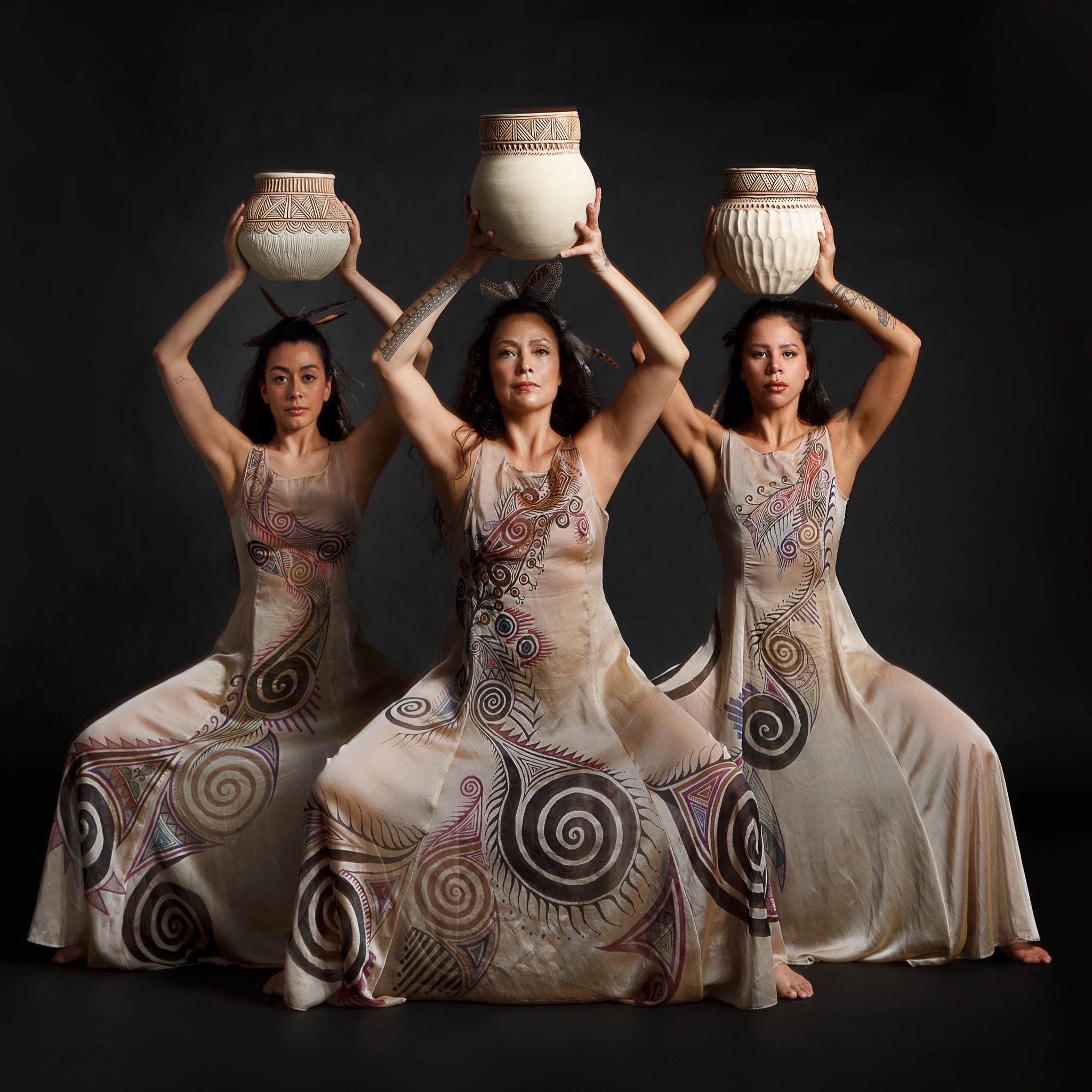
Sarah Prosper, Santee Smith & Katie Couchie Photo by David Hou
Tonight I attended the Live Art Dance presentation of Kaha:wi Dance Theatre’s Homelands as part of the Prismatic Arts Festival. There were just two performances of this show in Halifax, tonight and last night, but the Prismatic Festival is just getting started, and this is Live Art Dance’s first show of their season, so I encourage you to check out more information about upcoming events on their websites!
Homelands is a stunning multimedia hybrid dance show choreographed by Tekaronhiàhkhwa Santee Smith and performed by Smith with Sarah Prosper and Katie Couchie. The three dancers perform in space with the audience and then a whole cinematic world is projected on top of them. I have seen a lot of incredible uses of projections in the theatre over the last decade or so, but this was the first time that the performers really became part of the filmic background for me in a way that felt both three dimensional and at times overtly magical. This is the incredibly detailed work of Onkwehón:we filmmakers Shane Powless, Ian R. Maracle, Katsitsionni Fox, Jaiden Mitchell, Ami Kokui Tamakloe, and Louise Potiki Bryant, with animation by Emma López Hechem, and lightning by Sebastian Marziali.
As the title suggests this dance piece is very rooted in the natural world, the land, and specifically the land that Smith’s ancestors called home on Kahnyen’kehàka territory, and also Ohswé:ken, which is Smith’s own hometown. The overall theme of exploring the “umbilical” relationship (as Smith says) between the womxn and the land is vividly clear, but within this context the narratives and symbolism are left more up to the audience’s own experience and imagination. For me I felt at times like I was seeing five hundred years worth of history unfolding through the eyes of these three dancers, but I also felt at times that they were becoming the natural world too, that they could bring the storms and the forests and ocean and rivers into themselves and harness that power as well.
The dancers move with electric precision in a way that is utterly mesmerizing within the world created by the projections. The projections help to inform how we might see the movements, as sometimes I got the sense that our three protagonists were recoiling from a wasteland ravaged by fire or war, or both, and then at other times the dancers return to movements that seem more culturally significant and ceremonial, and the joy is infectious and the land around them thrives and blooms. I saw a lot of imagery centred around the idea of the draining of colour, of both the trees and the earth becoming sucked dry of their nutrients and their souls and becoming pale and cracked and arid. This is balanced with the continual imagery of the water- which will counteract this dryness, it will rejuvenate, and even, perhaps, literally wash the ‘whiteness’ away.
It is noteworthy that the score composed by singer/songwriter Pura Fé with additional vocalists Biine Kwe Elijah, Smith, and Jennifer Kreisberg showcases and centres female voices as well. Along with the visuals the music does so much to create a rich texture of emotions and narrative and thematic possibilities in a way that is both powerful and gorgeous. In Colonial history, of course, when Indigenous folks are mentioned it is very often the men that we learn about, in the context of the treaties that were signed, the alliances that were formed, and the acts of resistance against colonialism that took place across the country over centuries. Homelands is rooted in the womxn: the mother, the auntie, the sister, the grandmother, and their own resistance and resilience, and stewardship through time.
At the very last moment of the show my eyes suddenly welled with tears, and I wasn’t sure exactly why they all flooded in at that particular moment. There are moments where I felt the unbridled joy of the dancers and I wondered if the piece would end in that way as well- but instead it ended with something less tangible, but more poetic- perhaps a brand new beginning like the winter coming out of autumn, like the first buds of the green peaking out of the charred ground- I saw in the ending that same glimmer of possibility of a kind of rebirth, but still so fragile, so tenuous, but miraculous at the same time. I think that’s where the tears came from, from remembering how tender, yet also hardy, our relationship really is, with each other and with the land, and how they’re both irrevocably connected.
Prismatic Arts Festival continues in venues throughout Kjipuktuk Halifax until October 6th. For the full schedule of exciting programming, more information, and to buy your tickets please visit this website.





 World Theatre Day: My God Is It Ever The Time to Invest in Canadian Plays
World Theatre Day: My God Is It Ever The Time to Invest in Canadian Plays 